Everything You Need to Know About Termites
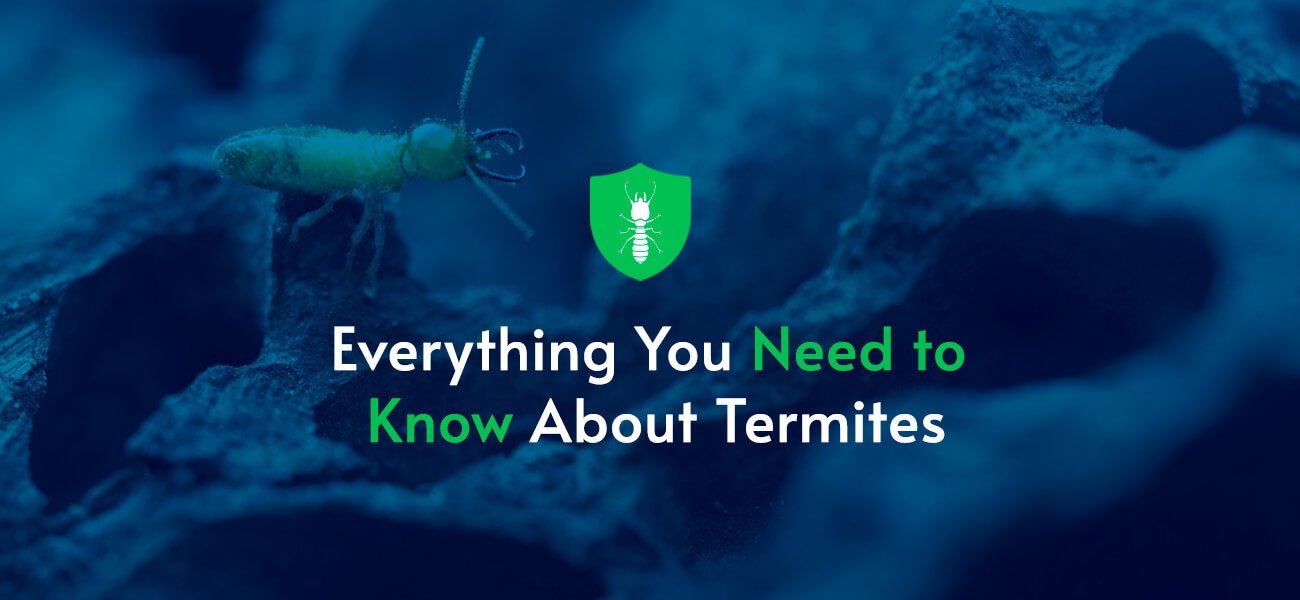
The stately oak desk you inherited from your grandmother has a place of honor in your home — but an infestation of termites could destroy this vintage piece in no time. Termites are one of the most destructive pests in the world. According to the National Pest Management Association, termites cause almost $5 billion in property damage each year. And since homeowners insurance doesn’t cover this type of damage, these costs come directly from your pocket.
Though termites are undoubtedly troublesome, there’s no need to panic if you’ve discovered an infestation. Professionals can use their training and expertise to save most homes. The first step to controlling a termite invasion of any size is to learn what to look for. In this guide, we’ll teach you everything you need to know about termites to help you get started. We’ll answer questions such as:
- How do termites look?
- What is the termite life cycle?
- What are the signs of termites in your home?
- What is the cause of termites?
- How do you get rid of termites?
Termites can be a property owner’s worst nightmare, but a professional pest management team gives you access to successful and long-lasting solutions. At Pestech Pest Solutions, we’ve helped businesses and homeowners solve their trickiest pest problems since 1989. If you live in the Hudson Valley region of New York and need to protect your home from pests today and tomorrow, contact us at Pestech Pest Solutions to learn more about our services.
Introduction to Termites
The adage is true — knowledge is power. The more you learn about termite species, the more empowered you are to identify the signs of an invasion and take action. Discover some facts about termites and why your property is no place for them to live.
What Should I Know About Termites?
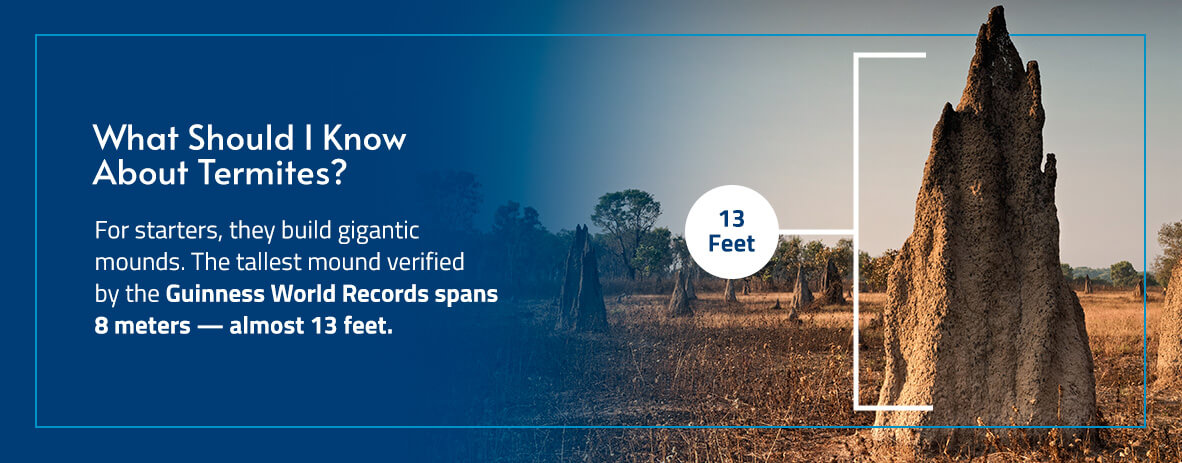
Termites are as fascinating as they are destructive. For starters, they build gigantic mounds. The tallest mound verified by the Guinness World Records spans 8 meters — almost 13 feet. Aside from wood, they also eat substances such as wallpaper, fabrics and plastic. Here are some other quick facts about termites:
- A termite’s hindgut contains as many as 1,400 microbiomes.
- They release approximately 150 million tons of methane gas annually.
- They’re pioneers in air conditioning — their tall mounds breathe air into their underground nests.
- Some queen termites lay up to 40,000 eggs a day.
- Termites are a delicacy in some cultures.
How Worried Should I Be About Termites?
If you have an experienced pest control team on speed dial, there’s no need to be too worried about termites. However, they are one of the most destructive insects, so you must act swiftly. Here is how to identify termites in your home.
- Mud tunnels: These pathways enable subterranean termites to reach their food source. Look for telltale signs on your porch or attic ceiling.
- Miniscule holes: Treat small holes in furniture as red flags. Inspect all wooden items in your home or office to determine a course of action.
- Droppings: Termite droppings and sawdust are the makings of a termite infestation. Take immediate action when you spot this combination.
- Broken wings: You will likely find eggs — and wings — scattered around your home after a swarming session. Noticing broken wings in or around your home could indicate an infestation.
Termite Identification
Most people associate termites with eating machines, and they’re right — termites eat 24/7.
These pests have had millennia to hone their skills. Scientists estimate the earliest termites lived 250 million years ago — even before the first dinosaurs walked the Earth. However, termites did not become pests until people started building homes and other wooden structures.
Surprisingly, termites fill a critical niche in nature because they help eliminate dead wood and return nutrients to the soil. They act as tiny recyclers by processing and discharging organic material, and they work nonstop. As they scurry about and churn the dirt they walk on, they also improve water infiltration, which helps moisturize the soil. Overall, their underground activity supports the surrounding plant life. But those benefits still do not justify keeping termites on your property.
If you suspect you have a termite infestation in your home or business, your first step is to identify the pest correctly. You’ll want to make sure you’re dealing with termites and not other insects like ants or cockroaches to take the correct treatment approach. In the next section, we’ll show you what termites look like so you know how to recognize them. If you have any questions along the way, reach out to us at Pestech Pest Solutions, and we’ll be happy to help.
What Are the Types of Termites?
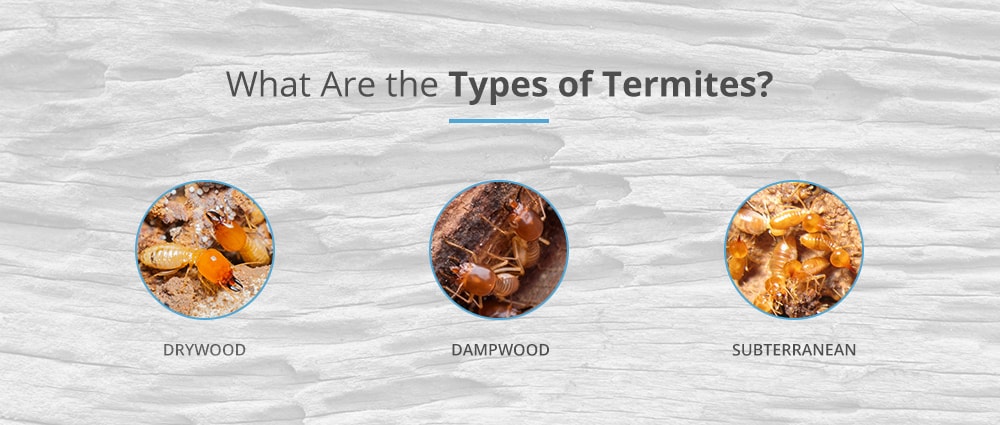
There are over 4,000 species of termites worldwide, each with distinct characteristics. We typically categorize termites by their habitat. Here are three of the most common termite types.
- Drywood: Drywood termites infest dry wood and don’t require any nutrients from soil. They may form multiple colonies in a single wood piece or structure and stay hidden in the material they use for food. Drywood termites require very little moisture and can even survive in dead wood found in the desert. They feed off anything from utility poles to furniture.
- Dampwood: As the name implies, dampwood termites make their homes in moist wood like decaying stumps and fallen trees. Since dampwood termites need lots of water to survive, a dampwood termite infestation in your home also indicates you have a severe moisture problem.
- Subterranean: Subterranean termites occupy the soil and wood in contact with the ground. To survive, they must live near a water source or stay in the dirt where they can obtain moisture. They live in home structures, fallen trees or stumps or any dead wood that touches the soil.
Subterranean termites are the most significant economic pest in the United States and cause most of the damage homeowners dread. They live in all states except Alaska. Subterranean termites have existed for more than 55 million years, so they know how to do their jobs. As you’ll see in the next section, termites have an entire caste system to help them fill different roles and thrive within their colonies.
What Does a Termite Look Like?
What do termites look like on wood? Termites share similar characteristics with many insects, particularly winged ants. Like other insects, their bodies have three regions — the head, thorax and abdomen. There are three categories of termites.

- Workers: The workers are the smallest. These sterile insects maintain the colony by searching for food and looking after the eggs.
- Soldiers: Birds, bats and other predators prey on termite colonies. Soldier termites stand guard and protect the queen and eggs.
- Reproductives: Tasked with the most valuable job, reproductives or swarmers keep the termite population strong. They leave the colony to mate and start new colonies.
Upon hatching, all termite nymphs are genetically identical and can mature into any of the three castes within the colony. Chemicals control the differentiation, production and regulation of these castes. Reproductive and soldier termites release a specific pheromone that spreads within the colony through food and grooming, preventing the development of future reproductives or soldiers. When something disrupts the caste equilibrium, some undifferentiated nymphs may not receive this pheromone signal, thus restoring balance.
Termites have a pair of straight, bead-like antennae on their heads that they use to detect smells. Termites also have chewing mouthparts like ants and grasshoppers. Their strong mouthparts have evolved to help them chew through wood. Soldier termites have large jaws to kill invaders, like ants.
The thorax, or middle region, has three sections, each containing a pair of legs. Mature reproductive termites have two pairs of wings attached to the last two segments of the thorax. The wings are long, narrow and of equal length and size. Reproductive termites lose their wings after swarming. In contrast, workers and soldiers do not develop wings.
What Does Termite Damage Look Like?
Termite-inflicted harm can resemble water damage at first glance. Observable indications of termite damage include warped wood, expanded floors and ceilings, sections that seem to exhibit minor water-related deterioration and intricate patterns within walls or furnishings. Additionally, termite infestations may emit an odor reminiscent of mildew or mold.
How Do You Tell the Difference Between Termites and Ants?
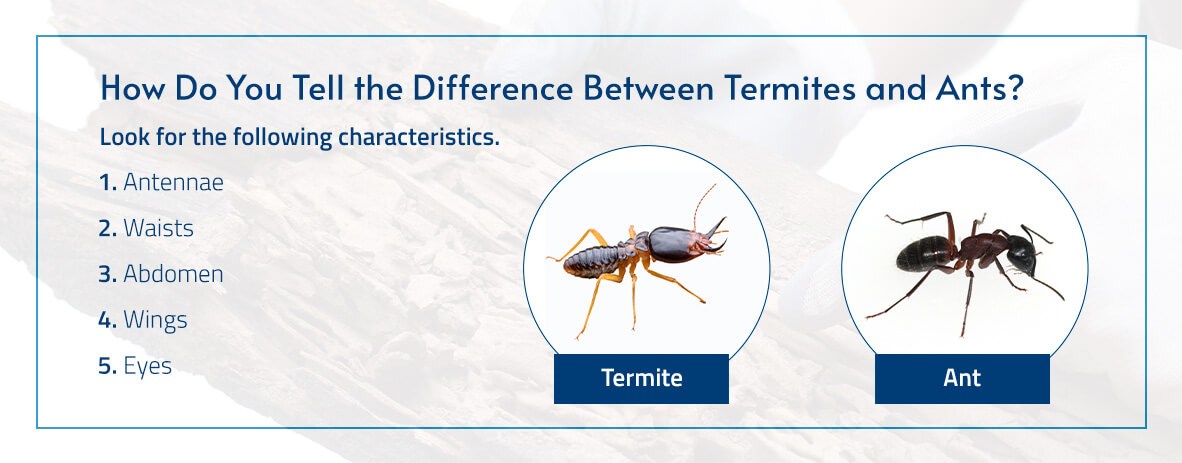
Termites are easy to confuse with carpenter ants because they’re about the same size and they both like to damage wood structures. However, there are simple ways to tell the difference between the two. Look for the following characteristics.
- Antennae: Termites have straight antennae consisting of bead-like structures. In contrast, ants have bent or “elbowed” antennae.
- Waists: Ants have pinched waists, and termites have broad waists.
- Abdomen: An ant’s abdomen has a pointed end, whereas a termite has a rounded end.
- Wings: Both insect species have four wings. However, they don’t look the same. Ants’ forewings are much bigger than their hindwings, but termite wings are all the same shape and size. Wing colors also vary between the two insects. Ant wings are typically either transparent or brownish, while termite wings have a milky color.
- Eyes: Ants rely on their eyesight to help them navigate the world around them. Most termite species are sightless, as they are born with tiny or nonexistent eyes.
How Big Are Termites?
If you find a termite, it’ll most likely be a worker. Generally, worker termites range in size from about one-quarter inch to three-eighths of an inch long, but they may be slightly smaller or bigger. Soldier termites may appear larger due to their shielded heads and strong jaws. Worker and soldier termites are approximately the same size as a carpenter ant, which is also around three-eighths of an inch long.
King and queen termites are larger than workers and soldiers and may be over an inch long. However, you’re unlikely to see the reproductive termites because they seal themselves in an underground chamber where they spend their lives.
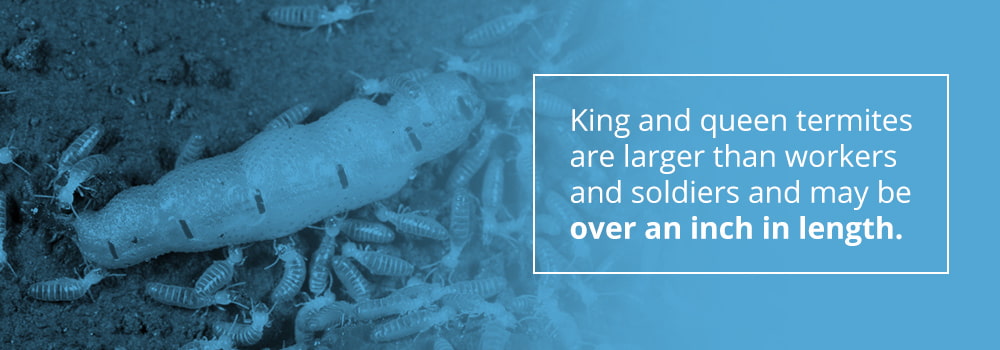
Are Termites Visible to the Human Eye?
Yes, termites are large enough to see with the naked eye. Generally, humans can see objects as small as 0.1 millimeters without tools like microscopes. Since termites range in size from about one-quarter inch to an inch, you should be able to spot them just fine.
Can Termites Fly?
Yes, some termites fly at specific times of the year. A termite colony will produce winged reproductive offspring called swarmers. Swarmers leave their original colonies in the spring to start new colonies with their chosen mates, but they don’t fly too far. Swarmers shed their wings after they land.
Are Flying Termites Dangerous?
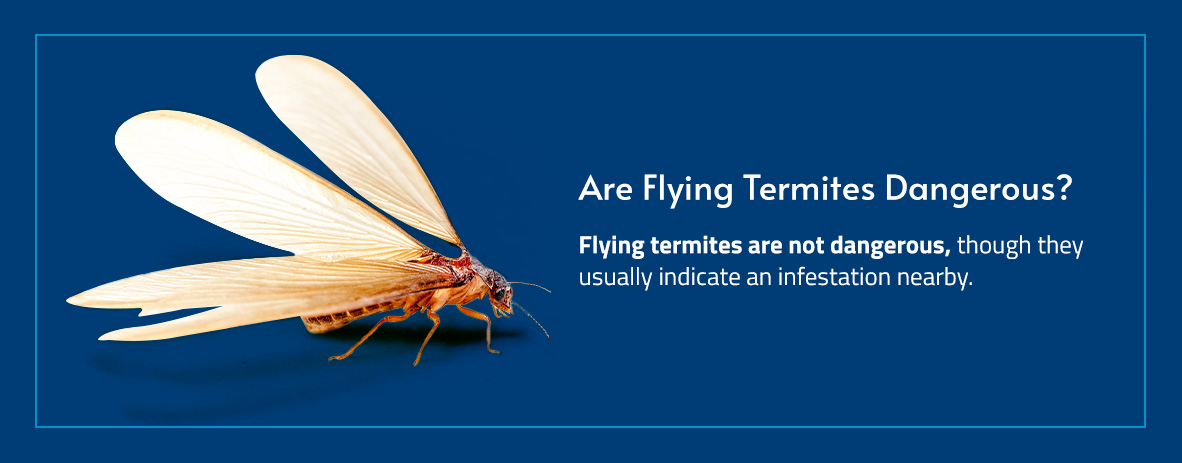
Flying termites are not dangerous, though they usually indicate an infestation nearby. A flying termite’s primary purpose in life is to reproduce and build a new colony — that’s it. Worker termites are the ones that eat through wood and cause structural damage.
Contact us to schedule your inspection!


